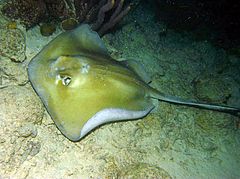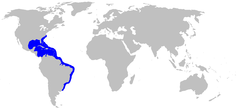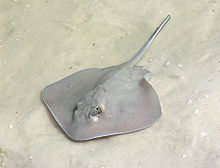- Southern stingray
-
Southern stingray 
Conservation status Scientific classification Kingdom: Animalia Phylum: Chordata Class: Chondrichthyes Subclass: Elasmobranchii Order: Myliobatiformes Family: Dasyatidae Genus: Dasyatis Species: D. americana Binomial name Dasyatis americana
(Hildebrand & Schroeder, 1928)
Range of the southern stingray The southern stingray, Dasyatis americana, is a stingray of the family Dasyatidae (the Whiptail Stingrays) found in tropical and subtropical waters of the Western Atlantic Ocean from New Jersey to Brazil. It has a flat, diamond-shaped disc, with a mud brown, olive, and grey dorsal surface and white underbelly (ventral surface).[2] The barb on its tail is serrated and covered in a venomous mucous, used for self defense.
Contents
Description
The southern stingray is adapted for life on the sea bed. The flattened, diamond-shaped body has sharp corners, making it more angular than the discs of other rays.[3] The top of the body varies between olive brown and green in adults, dark grey in juveniles, whilst the underside is predominantly white.[3][4] The wing-like pectoral fins are used to propel the stingray across the ocean bottom, whilst the slender tail possesses a long, serrated and poisonous spine at the base, used for defence.[5] These spines are not fatal to humans, but are incredibly painful if stepped on. The eyes are situated on top of the head of the southern stingray, along with small openings called spiracles. The location of the spiracles enables the stingray to take in water whilst lying on the seabed, or when partially buried in sediment. Water enters the spiracles and leaves through the gill openings, bypassing the mouth which is on the underside.[3][5] Female stingrays can grow to a disc width of 150cm, contrary to the smaller male stingrays that reach maximum size at 67cm.[6][7]
Behaviour and ecology
The southern stingray is an opportunistic forager, feeding on small crustaceans, such as alphaeid, penaeid and callianasid shrimp and brachyuran crabs[8]; mollusks, bony fish, and lancelets.[9] It feeds by flapping the wing-like pectoral fins to disturb the sand and expose the prey.[4] This bottom-dwelling species is often found singly or in pairs, except in the summer months when it migrates in schools to higher latitudes.[5][10]
Reproduction
Mating stingrays are rarely encountered in the wild. During one rare occasion, the male was observed closely following the female, and then biting her before grasping the female’s pectoral fins with his mouth, and then copulating. It is thought that southern stingrays are polyandrous, as a female was observed mating with two males in quick succession.[11] The southern stingray is ovoviviparous, a method of reproduction in which the egg develops within the female’s brood chamber. The pups hatch from their egg capsules inside the mother, and are born soon afterwards.[10] In captivity, gestation lasted 135 to 226 days, after which a litter of two to ten young were born.[12]
Human Interaction
In many parts of the Caribbean such as Grand Cayman Island and Antigua, the southern stingray swims with divers and snorkelers, and are hand fed on a locations such as Stingray City and the Sandbar.[13] On Turks & Caicos, they can be hand fed at a location called Gibbs Cay. Some have become tame enough to be cradled in visitors' arms and feed with pieces of cut up fish. There are concerns that this feeding, and the high levels of interaction with humans, may be having some negative impacts on the behaviour and ecology of the stingrays.[14]
The suction power of their mouth is similar to a very powerful vacuum cleaner.
References
This article incorporates text from the ARKive fact-file "Southern stingray" under the Creative Commons Attribution-ShareAlike 3.0 Unported License and the GFDL.
- ^ Grubbs, D.R., F. Snelson, A. Piercy, R.S. Rosa and M. Furtado (2006). Dasyatis americana. In: IUCN 2008. IUCN Red List of Threatened Species. Downloaded on January 8, 2010.
- ^ BIGELOW, H. & SCHROEDER, W. (1953) Fishes of the Western North Atlantic. Sawfishes, guitarfishes, skates and rays. Mem. Sears Found. Mar. Res.,. Mem. Sears Found. Mar. Res.,, 1, 1-558.
- ^ a b c Southern Stingray. Southern stingray Biological Profile, Ichthyology Department, Florida Museum of Natural History (August, 2007) - via ARKive
- ^ a b Lieske, E. and Myers, R. (2001) Coral Reef Fishes: Indo-Pacific and Caribbean. HarperCollins Publishers, London - via ARKive
- ^ a b c Carpenter, K.E. (2002) The Living Marine Resources of the Western Central Atlantic, Volume 1. Food and Agriculture Organization of the United Nations, Rome - via ARKive
- ^ HENNINGSEN, A. (2000) Notes on reproduction in the southern stingray, Dasyatis americana (Chondrichthyes: Dasyatidae), in a captive environment. Copeia, 2000, 826-828.
- ^ MCEACHRAN, J. & DE CARVALHO, M. (2002) Dasyatidae. In: K.E. Carpenter (ed.). The living marine resources of the Western Central Atlantic. Volume 1. Introduction, molluscs, crustaceans, hagfishes, sharks, batoid fishes and chimaeras. . 562–571.
- ^ GILLIAM, D. & SULLIVAN, K. (1993) Diet and Feeding Habits of the Southern Stingray Dasyatis americana in the central Bahamas. Bulletin of Marine Science.
- ^ STOKES, M. & HOLLAND, N. (1992b) Southern stingray (Dasyatis arnericana) feeding on lancelets (Branchiostoma floridae). Journal of Fish Biology.
- ^ a b Dasyatis americana, Southern Stingray. MarineBio.org (August, 2007) - via ARKive
- ^ Chapman, D.D., Corcorana, M.J., Harveya, G.M., Malanb, S. and Shivjia, M.S. (2003) Mating behaviour of southern stingrays, Dasyatis Americana (Dasyatidae). Environmental Biology of Fishes, 68: 241 - 245. - via ARKive
- ^ Henningsen, A.D. (2000) Notes on reproduction in the southern stingray, Dasyatis Americana (Chondrichthyes: Dasyatidae), in a captive environment. Copeia, 2000: 826 - 828. - ARKive
- ^ SEMENIUK, C. & ROTHLEY, K. (2008) Costs of group-living for a normally solitary forager: effects of provisioning tourism on southern stingrays Dasyatis americana. Marine Ecology Progress Series, 357, 271-282.
- ^ Guy Harvey Research Institute (August, 2007) - via [ARKive]]
External links
Categories:- IUCN Red List data deficient species
- Dasyatis
- Animals described in 1928
Wikimedia Foundation. 2010.


